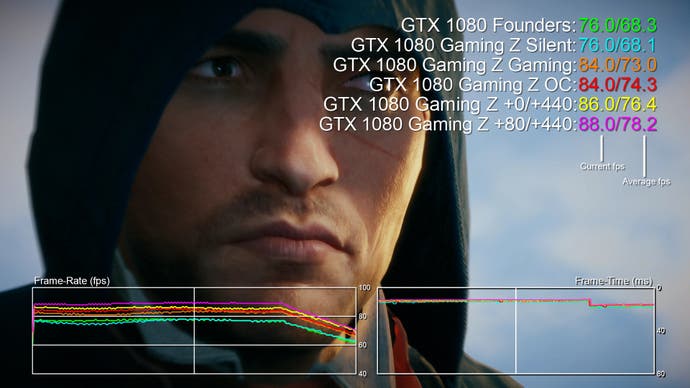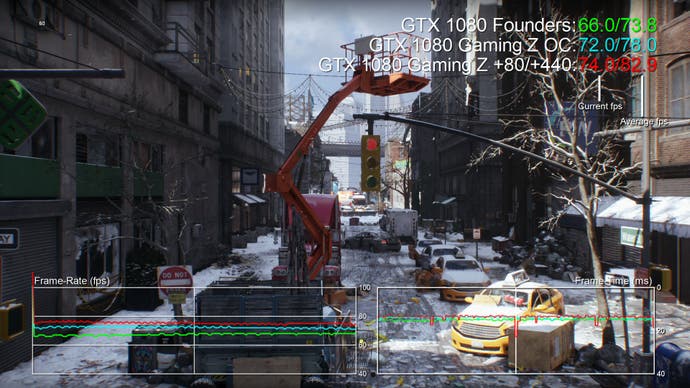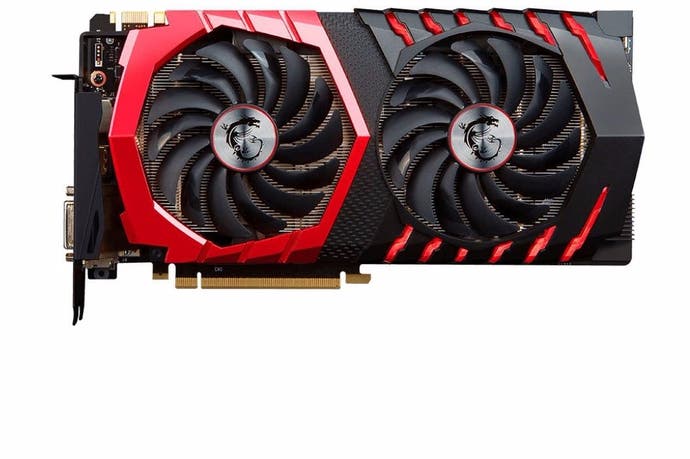MSI GeForce GTX 1080 Gaming Z review: Living the 4K dream?
It's the most powerful GPU on the market, but can we game at 60fps with UHD resolution?
It's not often that we review vendor-specific versions of graphics cards, but with MSI Gaming Z version of the GTX 1080 we had to make an exception. In our original review, we didn't have enough time to assess the overclocking potential of Nvidia's top tier card. But more than that, what we really wanted to do is quantify what the sheer level of power available is capable of delivering in terms of the actual gameplay experience. The big outstanding question was this: can GTX 1080 deliver locked 60fps gameplay at 4K on some of PC gaming's most demanding titles?
We've tried this in the past and failed. Whether we're testing GTX 980 Ti, Titan X or R9 Fury X, the fact is that the GPU power required to render UHD gameplay at high frame-rates on higher settings just proves too much. The end result tends to be a mish-mash of compromises - reduced resolutions, pared back settings, and rock-bottom frame-rates in really demanding scenes. The bottom line is that compromise-free 4K - or at least something close to it - requires a level of GPU power that previously wasn't available. The good news is that GTX 1080 gets close. Very close.
But first, let's take a look at what this MSI Gaming Z version of the GTX 1080 actually offers. Port selection is the same as the standard card - three DisplayPorts, HDMI 2.0 and dual-link DVI, but just about everything else sees a substantial upgrade and that starts with the thermal solution, based on MSI's new Twin Frozer 6 cooler. The new Torx 2 fan technology generates more airflow and higher pressure than its predecessor, meaning it can run 40 per cent quieter for the same cooling power. Compared to Nvidia's own Founders Edition, MSI reckon it's 20 per cent cooler and 35 per cent quieter.
The Gaming Z version is effectively an even more exclusive variant of the MSI's already top-tier Gaming X edition. The additional improvements here are pretty straight forward - the back plate gets an illuminated MSI Logo along with RGB lighting controlled by your PC via the MSI Gaming app. There are also slight tweaks to the factory overclocks you can select so it's a touch faster too. Crucially it's the same chip and the same cooling solution, so you should expect similar results once you roll up your sleeves and overclock it beyond the MSI-supplied presets.
Those presets consist of three different profiles: silent, gaming and OC. The former drops back the Gaming Z to reference clocks, easing the load and allowing for a less aggressive fan profile. Gaming adds a small but significant overclock, adding around seven per cent to in-game frame-rates. The default setting is OC, which is pretty impressive for an out-of-the-box factory OC. During gameplay, we regularly saw boost clocks exceed 1.9-1.95GHz, taking us close to the limits of Nvidia's GP104 technology. This gives us an effective nine per cent increase to performance.
But here's the thing. While MSI has factory-overclocked the core quite aggressively, speed boosts to the new GDDR5X memory are relatively slight - we're looking at around 100MHz added to the base 10GHz RAM speed. Based on the overclocking tests we've previously carried out on G5X, and indeed the results posted by many others in the wake of GTX 1080's launch, it's safe to say that you should have very few problems pushing up the memory speed to 11gbps.
Going into our overclocking tests, what became clear is that MSI has done a great job here in delivering a stable factory overclock. We could only add an additional 80MHz to the GP104 core - this results in in-game clocks hitting 2.1GHz before dropping back to 2080MHz, tending to push down again to 2050MHz where it's stable. This table gives you an idea of the clocks from each preset along with with custom OC profiles we came up with.

| GTX 1080 Founders | MSI GTX 1080 Silent | MSI GTX 1080 Gaming | MSI GTX 1080 OC (Default) | MSI GTX 1080 +0/+440 | MSI GTX 1080 +80/+400 | |
|---|---|---|---|---|---|---|
| AC Unity 1440p Low Frame-Rate | 51.0 | 52.0 | 55.0 | 55.0 | 58.0 | 59.0 |
| AC Unity 1440p Avg Frame-Rate | 64.0 | 64.3 | 68.7 | 69.7 | 71.9 | 73.3 |
| Core Clock | 1607MHz | 1607MHz | 1733MHz | 1771MHz | 1771MHz | 1851MHz |
| Boost Clock | 1733MHz | 1733MHz | 1873MHz | 1911MHz | 1911MHz | 1991MHz |
| Memory Clock | 10010MHz | 10010MHz | 10108MHz | 10108MHz | 11000MHz | 11000MHz |
You'll note that we've included our maximum achievable, stable overclock - plus another. Rather than push the core to its absolute limits, we left it on MSI's OC default, then simply added +440MHz to the G5X to take us up to 11GHz. Remarkably, this simple tweak provides 98 per cent of the performance of the maximum overclock we could extract from the card. And the advantages here are pretty straightforward - reduced power consumption, a cooler GPU and perhaps most importantly, a pretty much guaranteed level of stability. The fact is that the viability of bleeding-edge overclocks can change owing to a number of factors - at the most basic, summer gaming increases temperatures in your chassis and can de-stabilise what was previously a solid OC.
And that's the thing about manual overclocking - once you push to the very limits, you can achieve stability, but you can't run tests on every single game past, present and future in different surrounding conditions. With a factory overclock, the likes of MSI really have to deliver that.
That said, our +80 core/+440 RAM overclock did easily blaze through our entire benchmark suite, and by and large, it delivers another 15 per cent of performance. The big difference with the MSI card compared to Nvidia's Founders Edition comes down to acoustics (the fans are so much quieter when the core really gets hot) and temperatures. The Gaming Z remains in the 70-75 degree Celsius area, even when dragging the core kicking and screaming to its limits. But it's interesting to note that GP104 really doesn't seem to want to clock higher than a max 2.1GHz in a best case scenario - something we've seen during all of our testing on Nvidia's new Pascal technology.

| 2560x1440 (1440p) | GTX 1080 Founders | MSI GTX 1080 Factory OC | MSI GTX 1080 +80/+440 OC |
|---|---|---|---|
| Ashes of the Singularity, Extreme, 0x MSAA, DX11 | 68.6 | 74.0 | 78.0 |
| Crysis 3, Very High, SMAA T2X | 83.0 | 89.6 | 94.9 |
| The Division, Ultra, SMAA | 68.4 | 74.4 | 76.9 |
| Far Cry Primal, Ultra, SMAA | 77.0 | 80.7 | 84.6 |
| Hitman, Ultra, SMAA, DX11 | 85.2 | 91.6 | 95.6 |
| Rise of the Tomb Raider, Ultra, SMAA, DX11 | 88.7 | 93.0 | 99.5 |
| The Witcher 3, Ultra, Post AA, No HairWorks | 79.2 | 88.1 | 92.7 |
So with the benchmarks sorted and the overclock in place, it's time to actually play some games. Starting with Crysis 3 maxed out, our first efforts at achieving 4K at 60fps fall flat - 45fps is the best we can do. But here's the crucial question: to what extent do we actually need ultra settings? The truth of the matter is that there's usually a rule of diminishing visual returns when it comes to the small step from high to ultra, and a disproportionate increase on GPU load. Dropping Crysis 3 down from very high to high instantly locks us at 60fps in the same area. However, we do note that effects-heavy scenes - principally involving generous uses of alpha transparencies - do still see performance drops. And more generally, advanced effects work causes frame-rate issues on most demanding titles.
Moving on to The Witcher 3, we dip into the settings once more, engage the high preset and turn off the wasteful HairWorks technology. Loading up the Beast of White Orchard mission, GPU utilisation is at 80 to 97 per cent and we're locked at 40K60 in the lush engine-driven cut-scenes. However, once again, combat sees a drop to the 50fps area as the additional load of effects kicks in. Even dropping shadows and foliage to medium doesn't really help, gaining us just 3fps. For a truly demanding game, his is still a highly creditable showing though - and better than any other GPU we've tested at 4K.
Star Wars Battlefront? Using the testing Endor speederbike training mission as a stress-test, we can retain ultra settings on everything except shadows, effects and ambient occlusion where we dip to high. 4K60 with no problems here, and again, only heavy effects work causing momentary dips. Experimenting with medium quality shadows to free up some GPU time only went so far in getting that 60Hz lock, but to be clear, the drops in frame-rate were very infrequent and not really impactful to the gameplay. At 4K, this looks simply sensational.
In our tests, Overwatch at epic settings and Metal Gear Solid 5 on extra high (with shadows and ambient occlusion dropped to high) produces the most solid, consistent 4K60 experience we enjoyed from all of our test titles. The Blizzard game handed in a locked 60Hz from start to finish, with only minor drops on Kojima's epic - again when faced with lots of alpha transparency effects. In both cases though, the experience felt fantastic.
The biggest stumble came from GTA5 testing. With all standard settings maxed, but MSAA disabled and the grass preset at normal, we could enjoy prolonged 4K60 gameplay, but foliage-rich areas still caused issues. It seems like another weakness with alpha at 4K and it does beg the question of whether we're being let down here by the GP104 core, or else the lack of memory bandwidth.
The big takeaway from our testing is this: GTX 1080 is the most powerful single-chip GPU on the market, but more than that, for our money it is the only graphics card that can offer up 4K gameplay without crippling performance drops or undue compromise on settings. The benchmarks place it in a class of its own, and this is reflected by the experience. However, in many cases, a 60fps lock at UHD resolution proves elusive. A 4K monitor with G-Sync would iron out most of the issues though, and we would strongly recommend 45 or 50fps frame-rate caps if you have access to such a display - the quality of the experience there is surprising. We're also interested in testing GTX 1080 with a UHD TV, which would support 50Hz, lowering the GPU requirement.

MSI GeForce GTX 1080 Gaming Z - the Digital Foundry verdict
The GTX 1080 acquits itself very well as a 4K gaming card but the quality and consistency of the experience here is more solid thanks to the overclock we have in place, adding up to 15 per cent more performance. MSI's Gaming X and Gaming Z cards share the same thermal solution and both should do the job well here - not just in achieving a stable overclock but also in handing in far more agreeable acoustics too. Even with fans set manually to 70 per cent (overkill for cooling GP104) the card is still very quiet. The Gaming Z's core overclock is potent too - you can push it further manually but in terms of palpable frame-rate gains that genuinely make a difference to gameplay, there's little point. However, the G5X memory should be taken up to 11gbps, especially for 4K gaming, where it seems that memory bandwidth is still at a premium.
MSI's Gaming X and Z models attract a significant price premium - with the post-Brexit slide in the value of sterling raising prices still further - but side-by-side with the Founders Edition (which has its own price hike, remember) there's a night and day difference in terms of core temperatures and fan noise. And on top of that, build quality with the MSI board (based on a custom PCB) is on another level. It's a seriously impressive piece of kit, and a worthy successor to the firm's excellent work with Nvidia's last-gen Maxwell parts.
But what I really wanted to do with this review was to concentrate as much on the gaming experience as the benchmarks. Performance metrics are great as far as they go - but an average frame-rate does not sum up the kind of experience you're going to get playing a game, it's far more useful as an indicator of performance when compared to other GPUs running the same task. That's great as far as it goes, but doesn't really articulate how games actually play. In returning to the GTX 1080, what I've discovered is something pretty important - we finally have a graphics card with enough power to render 4K without too many compromises to the quality of the experience.











